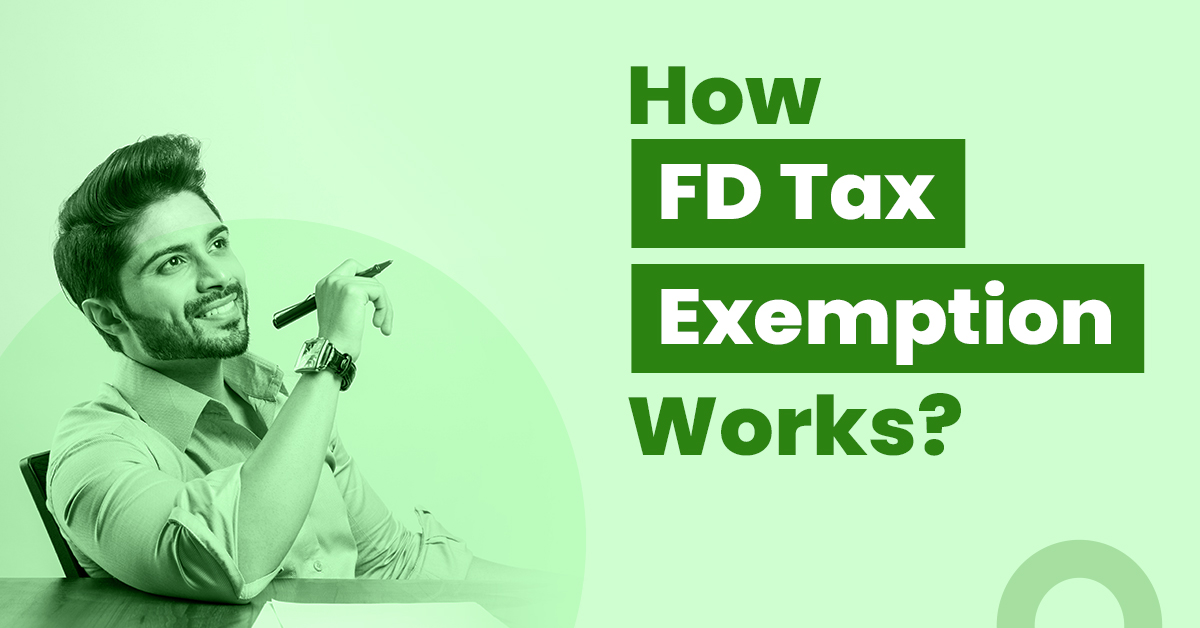Everything You Need To Know About Income Tax Deduction on FDs


A Fixed Deposit (FD) is the preferred investment instrument for risk-averse investors, especially senior citizens. Despite there being several new-age investment options, many with higher returns, FDs are integral to the investment portfolios of most investors as they park a significant chunk of their corpus in fixed deposits.
In fact, at the end of the fiscal year 2021-22, the total value of fixed deposits in public sector banks across India was approximately Rs. 99 trillion. Notably, the interest earned on bank FDs attracts income tax as per the tax slab applicable to the investor. However, there is a special category of fixed deposits that allows you to avail the benefit of tax deduction under Section 80(C) of the Income Tax Act.
What are Fixed Deposits?
A fixed deposit is an investment instrument offered by banks or non-banking financial companies (NBFCs) where a fixed amount is invested for a specific period. The investment tenure typically ranges from 7 days to 10 years.
Many investors prefer FDs because they offer a higher interest rate than average savings accounts. Bank FDs up to Rs. 5 lacs are also considered to be risk-free investments that earn a fixed rate of interest due to the insurance coverage provided by DICGC.
The interest rates offered by different banks/NBFCs vary based on their fiscal policies. Private sector banks and NBFCs usually offer a higher rate of interest than public sector banks. The interest rate of FDs also depends upon the tenure of the deposit – generally, the longer the tenure, the higher the interest rate. You can expect an interest rate ranging from 3% per annum to 8 % per annum on fixed deposits based on the tenure of the deposit and the bank/NBFC. Furthermore, senior citizens are offered a slightly higher rate of interest on FDs.
What is the TDS applicable on FDs?
When the interest earned on an FD reaches a certain threshold, i.e., Rs. 40,000 (Rs. 50,000 for senior citizens), the bank may deduct tax at the source, i.e., TDS. The TDS rate is 10%, (although you have to pay tax on the total income as per your tax slab). The bank will issue a TDS certificate, or Form 26A, with all the details. Don’t forget to mention the TDS amount when filing your returns, otherwise, you might end up paying the higher tax on your interest income.
Tax Benefits under Section 80C of the IT Act
The interest earned on Fixed Deposits is always taxable (senior citizens can claim a deduction of up to Rs. 50,000). However, if you book an FD for a tenure of 5 years, you can claim a deduction equal to the amount deposited (up to Rs. 1.5 lakhs) from your net taxable income under Section 80(C) of the Income Tax Act (please note that the interest earned is fully taxable except for the Rs. 50,000 deduction for senior citizens). Such FDs are often referred to as Tax-Saver FDs. Remember, you can only claim the tax deduction only for the investment year, not every year of the deposit tenure.
Also Read: Experience financial growth with unmatched Bajaj Finance FD Rates
Features of tax-saver FDs
Here are some of the features of tax-saver FDs:
- One can claim a fixed deposit income tax deduction of up to Rs. 1.5 lakhs from their net taxable income for the year in which the fixed deposit account is opened.
- The interest earned on FDs is always taxable (even on tax-saving FDs) as per your income tax bracket. However, senior citizens are allowed to claim a deduction of up to Rs. 50,000 on the interest amount.
- The interest rate on tax-saver FDs is the same for the five years. However, interest rates offered by different banks vary.
Eligibility to Claim Tax Deductions
You must open the tax-saver FD account in your name to claim a fixed deposit tax deduction. If it is a joint account, only the first account holder can claim the fixed deposit tax deduction under Sec 80(C) of the Income Tax Act.
Documents required
You need to furnish the following documents for opening a tax-saver FD account:
- Proof of identity: Passport, PAN card, Aadhaar card, Voter’s ID card, Driver’s licence
- Proof of residence: Passport, Bank statement with a bank cheque, Aadhaar card
- Proof of date of birth: PAN card, Voter ID, Aadhaar card, Certificate of service discharge
Tax-Saver FD vs ELSS: The Better Tax-Saving Instrument
It is not fair to claim that one type of investment is better than the other. Both come with pros and cons. Rather, it is more important to understand your risk appetite and tax liability and allocate funds accordingly.
Here’s a quick comparison between tax-saver FDs and equity-linked savings schemes, or ELSS — a type of mutual fund with over 60% invested in equity:
- The risk profile of the investment: There is almost zero risk associated with fixed deposits made with any of the nationalised banks. To make your investment even more secure, RBI offers complimentary insurance cover worth up to Rs. 5 lakhs on bank FDs. On the other hand, the returns of ELSS are market-dependent. While there is a possibility of earning much higher returns, you might also lose your capital in ELSS.
- Investor profile: An FD is a safe bet for you if you do not wish to take any risks. However, the returns that you can earn on FDs are also lower.
On the other hand, ELSS is a wealth creation instrument, which appreciates as the market rises. If you are willing to take some risk, this is a comparatively safer bet than directly investing in the stock market.
- Lock-in period: The lock-in period for a tax-saver FD is five years. On the other hand, you must stay invested in an ELSS for three years.
- Loans/overdraft: You can take a loan or overdraft on non-tax saver FDs. There is no such feature under ELSS.
- Taxation: Interest per annum earned on fixed deposits is taxed according to your tax bracket (deduction of up to Rs. 50,000 for senior citizens under Section 80 TTB). In the case of ELSS, you are only taxed when units are redeemed, resulting in profits exceeding Rs. 1 Lakh. If redeemed before three years, this attracts a Short Term Capital Gains tax of 15%, and after three years, a Long Term Capital Gains tax of 10% is applicable.
- Rate of returns: ELSS can offer higher, but there is a risk involved as the returns are dependent on the performance of the equity markets. On FDs, you earn a fixed rate of interest of between 3 to 8%, and there is no risk upto 5 lacs due to insurance coverage.
Conclusion
A tax-saver FD can be a really good investment instrument from a tax-saving standpoint, plus, you also get the safety and the peace of mind associated with a fixed return instrument. That being said, if you wish to build wealth over a long time horizon, considering other higher return asset classes is a better idea.
FAQs about Income Tax Deduction on FDs
Is premature withdrawal possible in tax-saver FD?
To avail of a fixed deposit tax benefit, you need to invest in a tax-saver FD for five years. This means there is a lock-in period of five years. You cannot withdraw, take a loan or get an overdraft during this time. It’s advised to have a separate emergency fund as a hedge against any financial crunch that you may face.
How much of an FD’s interest is tax-free?
Interest earned on fixed deposits is always taxable (even for tax-saving FDs). However, senior citizens can claim a deduction of up to Rs. 50,000 on the interest earned under Section 80TTB of the Income Tax Act.
Are all FDs tax-saving FDs?
No, tax-saving FDs are a special category of FDs that have a lock-in period of five years.
What is the difference between normal FD and tax-saving FD?
A normal FD does not offer any tax deduction benefit. However, a tax-saving FD offers an income tax deduction of up to Rs. 1.5 lakhs under Section 80C of the Income Tax Act. The duration of regular FDs is between seven days and 10 years, while tax-saver FDs have a lock-in period of five years.




